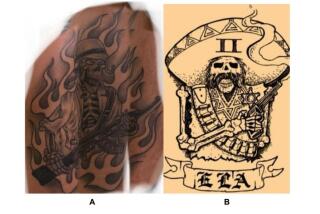Lynwood Deputies’ Reported Gang-Style Activity Investigated
- Share via
Los Angeles County Sheriff Sherman Block said Monday a department inquiry is being conducted into reports that a clique of deputies in the Lynwood station have adopted some forms of street-gang behavior and have been intimidating department supervisors and citizens.
The station is said to harbor a group of deputies who have adopted such gang-like expressions as tattoos, graffiti-spraying, street jargon and hand signs. Nearly half of the 125 deputies assigned to the area are said to belong to the group.
According to an article in Sunday’s Long Beach Press-Telegram, the deputies call themselves the “Vikings” or “LVS25,” and use terms such as “homeboy” or “OG,” for “original gangster,” when addressing each other.
“Allegations of improper conduct will be investigated,” Block said, after a swearing-in ceremony for his third term. He indicated that he was not concerned about many of the activities described in the account.
Block did not object to deputies forming groups, saying “the fact that a group of people with a particular assignment band together in a sort of brotherhood could be a very positive thing. . . . In almost all of the stations there have been groups formed, as a badge of honor, if you will.”
Nor was Block opposed to deputies using special words and hand signals. “I have no problem with street jargon,” he said. “The fact they flash an L sign, L for Lynwood, 25 (the number for the Lynwood station), that in itself is meaningless. . . . Gangs get a kick out of the fact the deputies have their own sign.”
As for tattoos, sheriff’s spokesman Fidel Gonzales quoted Block as saying: “A lot of guys in Saudi Arabia are wearing tattoos right now.”
The Press-Telegram account said graffiti had been sprayed on walls in the station area, but Block said, “We have yet to be able to find any.”
The Lynwood station serves a 7.6-square-mile area that includes Lynwood, Compton and Willowbrook and has the highest number of gang-related homicides--31 this year--of those portions of unincorporated Los Angeles County policed by the Sheriff’s Department, according to department officials.
Social groups organized at sheriff’s stations are not new. Deputies at the Firestone station have formed an intramural sports team called the Pirates. In addition, retired Sheriff’s Capt. Hayden Finley recalled a group formed in the East Los Angeles station in the late 1970s called “the Little Devils.”
“Their tattoo was a caricature of the devil . . . and they associated with each other after work,” Finley said. “Most of them worked the early morning shift.”
Lynwood Mayor Robert Henning said that although he was familiar with the existence of such groups, “from what I understand it turned into something else inside Lynwood station.”
“But it has not impacted the community,” Henning said. “It’s internal.”
Some of the deputies associated with the group boasted that a sergeant was forced out of the station last year after officers put feces on his car engine, tied dead animals underneath the vehicle and poured coffee on his files.
“He thought he was God’s gift to police work and found fault with anything we did,” said one deputy who asked that his name not be used.
The deputy also suggested that the clique’s behavior was largely due to the stress of policing the crime-plagued area.
The Lynwood station, located in a largely black and Latino city of 55,844 people, eight miles south of Los Angeles, also came under fire last September when 81 residents filed a federal class-action suit, charging members of the station with brutality and racism.
The suit, filed in U.S. District Court, accused 22 deputies of 43 incidents of “shooting, brutality, terrorism, house trashing and excessive force.”
George V. Denny III, lead counsel for the plaintiffs, said community residents had told him about the clique and “other sources said they’ve made it very hard on black people.”
Lynwood Capt. Bert Cueva could not be reached for comment. Cueva told the Press-Telegram that he had been attempting to deal with the clique since he arrived at the station in June, 1989. A citizen had complained about the station’s use of a blond Viking head “mascot” while it serves the area’s largely black and Latino population.
More to Read
Sign up for Essential California
The most important California stories and recommendations in your inbox every morning.
You may occasionally receive promotional content from the Los Angeles Times.











